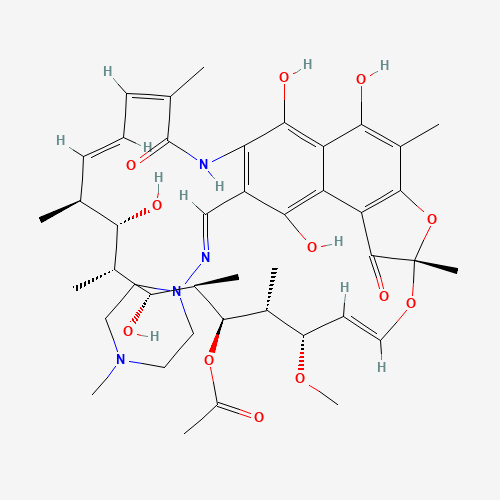| Pharmaceutical Information |
| Drug Name |
Rifampicin |
| Drug ID |
BADD_D01936 |
| Description |
A semisynthetic antibiotic produced from Streptomyces mediterranei. It has a broad antibacterial spectrum, including activity against several forms of Mycobacterium. In susceptible organisms it inhibits DNA-dependent RNA polymerase activity by forming a stable complex with the enzyme. It thus suppresses the initiation of RNA synthesis. Rifampin is bactericidal, and acts on both intracellular and extracellular organisms. (From Gilman et al., Goodman and Gilman's The Pharmacological Basis of Therapeutics, 9th ed, p1160) |
| Indications and Usage |
For the treatment of Tuberculosis and Tuberculosis-related mycobacterial infections. |
| Marketing Status |
approved |
| ATC Code |
J04AB02 |
| DrugBank ID |
DB01045
|
| KEGG ID |
D00211
|
| MeSH ID |
D012293
|
| PubChem ID |
135398735
|
| TTD Drug ID |
D0G3DL
|
| NDC Product Code |
73005-0006 |
| UNII |
VJT6J7R4TR
|
| Synonyms |
Rifampin | Benemycin | Rifampicin | Rimactan | Tubocin | Rifadin | Rimactane |
|
| Chemical Information |
| Molecular Formula |
C43H58N4O12 |
| CAS Registry Number |
13292-46-1 |
| SMILES |
CC1C=CC=C(C(=O)NC2=C(C(=C3C(=C2O)C(=C(C4=C3C(=O)C(O4)(OC=CC(C(C(C(C(C(C1O)C)O)C)
OC(=O)C)C)OC)C)C)O)O)C=NN5CCN(CC5)C)C |
| Chemical Structure |

|
|
| ADRs Induced by Drug |
|
|
*The priority for ADR severity classification is based on FAERS assessment, followed by the most severe level in CTCAE rating. If neither is available, it will be displayed as 'Not available'.
**The 'Not Available' level is hidden by default and can be restored by clicking on the legend twice..
|
|
|

